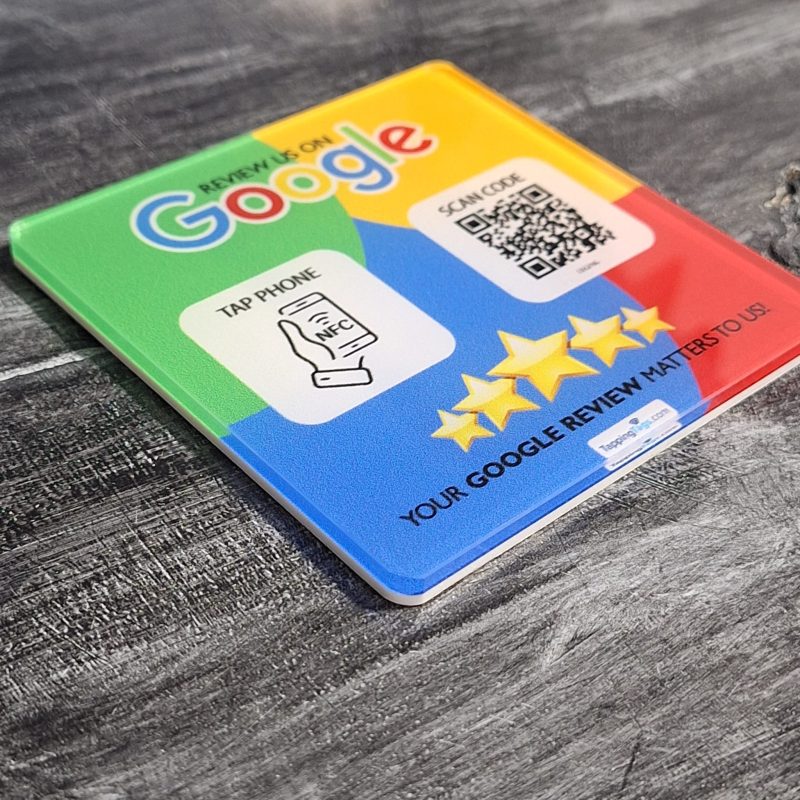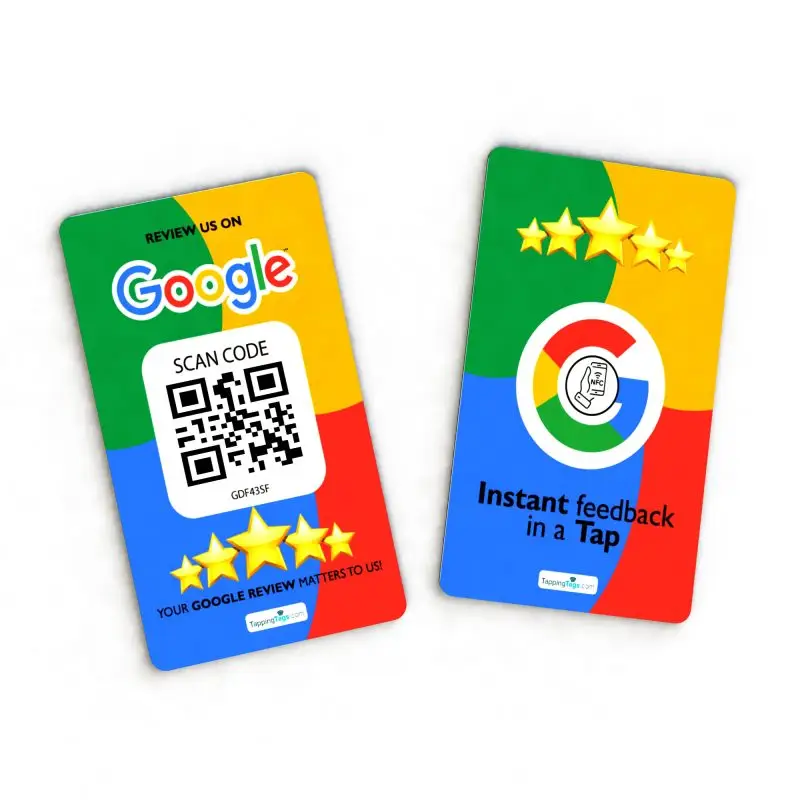Blog
Strategies for Improving Your Online Reputation
In today’s digital landscape, maintaining a positive online reputation is crucial for businesses of all sizes. With consumers increasingly relying on online reviews to make purchasing decisions, implementing effective strategies for improving your online reputation can significantly impact your success. One innovative approach is utilizing cutting-edge technology, such as Tapping Tags’ Google Review NFC cards. These cards streamline the customer feedback process by allowing users to access a business’s review page with a simple tap of their NFC-enabled smartphone. This not only enhances the customer experience but also encourages more reviews, ultimately boosting your online visibility and credibility. By focusing on strategies that increase engagement, enhance your online presence, and improve your search engine optimization (SEO), you can effectively manage and elevate your brand’s reputation in the competitive online marketplace. Whether you’re a mobile service provider or a brick-and-mortar business, leveraging tools like Tapping Tags can help you gather valuable feedback and foster trust among potential customers.
Building a Strong Personal Brand Through Consistent Messaging
In today’s digital landscape, building a strong personal brand is essential for anyone looking to enhance their online reputation. A personal brand is not just about having a catchy tagline or a polished profile; it is about creating a consistent and authentic message that resonates with your audience. Consistent messaging plays a pivotal role in establishing trust and credibility, which are crucial components of a positive online reputation.
To begin with, it is important to define what consistent messaging means in the context of personal branding. Consistent messaging involves maintaining a uniform voice, tone, and style across all platforms where you engage with your audience. This includes social media, personal websites, blogs, and any other online presence. When your audience encounters your brand, they should immediately recognize it, regardless of the platform. This recognition fosters familiarity, which can lead to trust and loyalty.
One of the key strategies for achieving consistent messaging is to develop a clear brand identity. This identity should encompass your values, mission, and the unique qualities that set you apart from others in your field. According to a study by the Harvard Business Review, 64% of consumers cite shared values as the primary reason they have a relationship with a brand. Therefore, it is crucial to articulate your values clearly and ensure that they are reflected in every piece of content you create.
Moreover, storytelling is an effective way to convey your brand identity. People are naturally drawn to stories, and sharing your personal journey can help humanize your brand. By consistently sharing your experiences, challenges, and successes, you create a narrative that your audience can connect with. This not only enhances your personal brand but also establishes an emotional connection with your audience, making them more likely to engage with your content and share it with others.
Another important aspect of consistent messaging is the use of visuals. Visual elements such as logos, color schemes, and typography should be consistent across all platforms. According to research by the University of Loyola, Maryland, color increases brand recognition by up to 80%. Therefore, investing time in creating a cohesive visual identity can significantly enhance your brand’s recognition and recall.
Engagement is also a critical component of consistent messaging. Regularly interacting with your audience through comments, messages, and social media posts helps reinforce your brand’s presence. It is essential to respond to inquiries and feedback promptly, as this demonstrates that you value your audience’s opinions and are committed to building a relationship with them.
Furthermore, leveraging user-generated content can amplify your messaging. Encouraging your audience to share their experiences with your brand not only provides social proof but also reinforces your brand message. When others share their positive experiences, it enhances your credibility and can attract new followers who are interested in what you have to offer.
To maintain consistency, it is also advisable to create a content calendar. This tool helps you plan and organize your content in advance, ensuring that your messaging aligns with your brand identity and goals. A content calendar can also help you track your engagement metrics, allowing you to adjust your strategy based on what resonates most with your audience.
In addition, monitoring your online presence is crucial for maintaining a strong personal brand. Regularly checking your social media profiles, website, and any other platforms where you are active allows you to identify any inconsistencies in your messaging. Tools like Google Alerts can help you stay informed about mentions of your name or brand, enabling you to respond promptly to any discussions or feedback.
Finally, it is important to remember that building a strong personal brand is an ongoing process. As you grow and evolve, so too should your messaging. Regularly revisiting your brand identity and making adjustments as necessary will ensure that your personal brand remains relevant and resonates with your audience.
In conclusion, building a strong personal brand through consistent messaging is a multifaceted endeavor that requires careful planning and execution. By defining your brand identity, engaging with your audience, leveraging visuals, and monitoring your online presence, you can create a powerful personal brand that enhances your online reputation. Remember, your personal brand is a reflection of who you are, and consistency is key to ensuring that your message is heard and recognized. For more insights on improving your online reputation, consider exploring additional resources on our website, such as our home page or our about section.
References:
- Harvard Business Review. “The Brand Called You.” Retrieved from https://hbr.org/1997/01/the-brand-called-you
- University of Loyola, Maryland. “Color Psychology: How Colors Influence the Brand.” Retrieved from https://www.colorpsychology.org/
- Google Alerts. “Stay informed about your brand.” Retrieved from https://www.google.com/alerts
Engaging with Your Audience: The Key to Positive Online Interactions
In today’s digital landscape, engaging with your audience is more crucial than ever for fostering positive online interactions and enhancing your overall online reputation. The way you communicate with your audience can significantly influence their perception of your brand, product, or service. Effective engagement goes beyond merely responding to comments or messages; it involves creating a genuine connection that resonates with your audience’s needs and interests.
To begin with, understanding your audience is fundamental. Conducting thorough research to identify their preferences, pain points, and behaviors will enable you to tailor your content and interactions accordingly. Utilize tools such as surveys, social media analytics, and customer feedback to gather insights. This information will help you create content that speaks directly to your audience, making them feel valued and understood.
Once you have a clear understanding of your audience, the next step is to create engaging content that encourages interaction. High-quality content that is informative, entertaining, or thought-provoking can capture your audience’s attention and prompt them to engage with your brand. Consider using various formats such as videos, infographics, and blog posts to diversify your content and cater to different preferences. For instance, a well-crafted blog post on your website can provide in-depth information, while a short video on social media can deliver quick, engaging snippets that resonate with viewers.
Moreover, fostering a two-way communication channel is essential for positive online interactions. Encourage your audience to share their thoughts and opinions by asking questions and inviting feedback. Responding promptly and thoughtfully to comments and messages demonstrates that you value their input and are committed to building a relationship. This not only enhances customer satisfaction but also encourages others to engage with your brand, creating a vibrant online community.
Another effective strategy is to leverage social media platforms to connect with your audience. Social media is a powerful tool for engagement, allowing you to reach a broader audience and interact in real-time. Share behind-the-scenes content, host live Q&A sessions, or run interactive polls to encourage participation. By showcasing the human side of your brand, you can foster a sense of belonging and loyalty among your audience.
Additionally, consistency is key in maintaining engagement. Regularly updating your content and interacting with your audience helps keep your brand top-of-mind. Create a content calendar to plan your posts and ensure a steady flow of fresh content. This not only keeps your audience engaged but also signals to search engines that your website is active, which can positively impact your online visibility.
Furthermore, consider collaborating with influencers or industry experts to expand your reach and credibility. Partnering with individuals who resonate with your audience can introduce your brand to new followers and enhance your reputation. Influencers can create authentic content that showcases your products or services, providing social proof that can significantly influence potential customers.
Lastly, always monitor your online presence and be proactive in managing your reputation. Use tools to track mentions of your brand across various platforms and respond to both positive and negative feedback. Addressing concerns promptly and professionally can turn a negative experience into a positive one, showcasing your commitment to customer satisfaction.
In conclusion, engaging with your audience is a vital component of improving your online reputation. By understanding your audience, creating compelling content, fostering two-way communication, leveraging social media, maintaining consistency, collaborating with influencers, and actively managing your online presence, you can cultivate positive interactions that enhance your brand’s image. For more insights on enhancing your online presence, visit our home page or learn more about our services on the about page. If you have any questions or need assistance, feel free to reach out through our contact page.
In conclusion, improving your online reputation is an ongoing process that requires dedication, strategy, and a proactive approach. By actively managing your digital presence through consistent engagement on social media, responding to reviews, and creating valuable content, you can cultivate a positive image that resonates with your audience. Additionally, monitoring your online mentions and utilizing tools to track your reputation will help you stay ahead of any potential issues. Remember, transparency and authenticity are key; being genuine in your interactions fosters trust and loyalty among your audience. By implementing these strategies, you can not only enhance your online reputation but also build a strong foundation for long-term success in the digital landscape. Embrace the journey, and watch as your efforts transform your online persona into one that reflects your true values and strengths.
-
 Google Review NFC and QR Code Acrylic Stand
Rated 5.00 out of 5
Google Review NFC and QR Code Acrylic Stand
Rated 5.00 out of 5$75.00Original price was: $75.00.$38.50Current price is: $38.50. -
 Google Review NFC & QR Code Acrylic Tag with Sticker
Rated 5.00 out of 5
Google Review NFC & QR Code Acrylic Tag with Sticker
Rated 5.00 out of 5$49.00Original price was: $49.00.$27.00Current price is: $27.00. -
 Google Review NFC and QR Code Card - Tap or Scan
Rated 5.00 out of 5$18.90 – $98.90
Google Review NFC and QR Code Card - Tap or Scan
Rated 5.00 out of 5$18.90 – $98.90
